White Ibis are abundant in North Carolina, making them a responsibility species for Audubon. It’s important to maintain safe, high quality nesting sites and other habitats to ensure their populations remain healthy.
Learn where to find them, how to help them, and more in this Priority Bird Profile: White Ibis.
Why does this bird matter to Audubon NC?
White Ibis roam over large areas and colonize when they find suitable nesting habitat. They were first recorded breeding in North Carolina in 1889, but they were not found nesting in large numbers until 1950 when more than 1,000 were discovered breeding near Lumberton in Warwick Mill Bay, a freshwater wetland.
Then, in the early 1960s, White Ibis began to appear on Battery Island, an estuarine island near Southport on the Lower Cape Fear River. Numbers grew every year, and now as many as 14,000 pairs nest on the island in a single season!
Battery Island (which Audubon North Carolina manages) is host to the largest White Ibis colony in North Carolina and a designated Important Bird Area for its global significance in maintaining their population.
Where can people see this bird/when?
With its long, down-curved bill and bright white plumage, the White Ibis is easily identifiable. When groups wade through shallows, probing with their long bills, other wading birds such as egrets may follow them to catch prey stirred up by the ibises!
SPRING & SUMMER
They can be seen foraging on lawns or neighborhood ponds, especially in August after nesting season finishes, but marshes, swamps and other wetlands are their native habitat. White Ibis are highly social nesters, and they may gather by the thousands to nest in large colonies from April to July. Look for them near nesting colonies from April through July, especially in Brunswick County and around Harker’s Island.
“Visit” Battery Island via our 360 video below, where the sound of White Ibis chicks begging for food is almost indistinguishable from cicadas on a summer night! This colony tallied over 10,000 pairs of nesting White Ibis in 2017.
WINTER
It is common for the White Ibis to be seen along the coast during the winter months, they love foraging in shallow water!
How is Audubon NC helping this bird?
Audubon North Carolina works with partners to manage important nesting areas for White Ibis (as well as other wading birds). The Orton Foundation is generously supporting our work managing and protecting Battery Island and other Cape Fear River sites and helping us share these special places with the public through videos and media.
The Cape Fear Garden Club is also a vital supporter of Battery Island, and have supported our work there for over two decades. Recently, two UNC-Wilmington graduate students also completed studies on shoreline change and plant communities on Battery Island—both important factors in maintaining the island for ibis and other species.

How can locals or beach visitors help this bird?
Birds are essential to the function of healthy ecosystems and drive significant business in tourism and other industries, so it’s important we take care of their homes. Their protection ensures the integrity of habitat for many other species, including humans, and biological diversity.
Important Bird Areas (IBAs) designate areas that are critical to bird populations in North Carolina. The following IBAs are important to White Ibis as nesting sites. Sites with an asterisk are managed by Audubon.
- Battery Island*
- Hog Island
- Morgan Island
- North Pelican Island*
- Old House Channel Island
- Roanoke Sound Island
Here are some easy ways you can help White Ibis, as well as other coastal birds.
- Pay attention to beaches and islands with signage or fences, these are areas that birds could be nesting and when birds are disturbed off their nests, their eggs and chicks are exposed to danger from predators and extreme temperatures.
- Be attentive to birds. Even if you are outside a posting, if birds fly up and are agitated, you are too close. Move back and let them settle down.
- Avoid anchoring your boat on or near an island with groups of nesting birds
- Try not to feed gulls. Feeding them can lead to an unnaturally higher number of gulls, who can prey on other birds’ young and eggs.
- Report incidents of nest destruction and disturbance to the North Carolina state wildlife agency.
- Pack out all your trash, including food, and discard fishing line properly. Birds can become entangled in the line and become injured.







